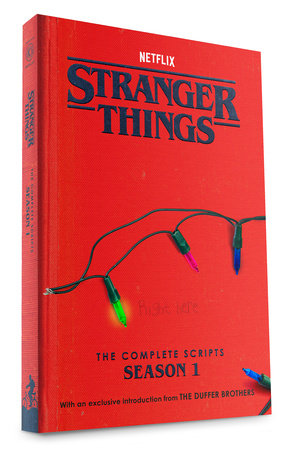Excerpt
Stranger Things: The Complete Scripts, Season 4
IntroductionSeason four was our toughest season to write, with the possible exception of season two. We had wanted to shake things up at the end of season three to challenge ourselves, but as we began to brainstorm this season, panic set in. For the first time, our characters were split up geographically—in California, Russia, and Hawkins. How were these storylines going to weave together in a coherent way? Even more challenging, our “kids” were no longer kids, but young adults. We could no longer rely on the middle school joy that defined the heart of the first three seasons. This was new, scary territory.
We also knew that this was the penultimate season. We needed to lay track for the ending, and that meant finally pulling back the curtain on the show’s ultimate villain. From the beginning, we knew there was a dark, sentient being behind all the evil in Hawkins: One, the first child in Brenner’s program, a twisted reflection of Eleven. We had always compared him to Pennywise, Pinhead, and Freddy Krueger. When we were kids, even hearing about these monsters freaked us out and gave us so many sleepless nights. We wanted One to be just as scary. But what would make our monster unique? We didn’t know his appearance, the extent of his powers, or his backstory. For weeks, we were stuck.
The answer, it turned out, lay inward—back in our own high school years. Unlike our middle school experience, which was so fun and hopeful, high school was a far darker period. We weren’t bullied, not exactly, but most of our closest friends drifted away. Some went to different schools, while others joined sports teams and made cooler friends. Gone were the days of playing Magic: The Gathering and making horror movies over the weekend. We felt left behind, lost, scared, and worst of all, invisible. Our experience was hardly unique—many kids had it much, much worse. This is the time in life when social pressures peak at the precise moment your body and mind are undergoing intense change. Inevitably, you’re plagued by self-doubt and insecurity.
While it was scary to reopen old wounds, we knew this would be rich, new territory to explore with our heroes. But how could our villain embody it? We spitballed with the writers: What if he fed on all of that—your darkest thoughts, your deepest fears? What if he could slip inside your mind and turn it against you? What if he sought out the kids who were already struggling, the ones most vulnerable? And what if he didn’t just haunt you, but killed you—a supernatural serial killer? That was our answer. Now he just needed a name. We opened our D&D book one more time and found it: one of its most infamous villains, a dark, spellcasting wizard known as Vecna.
We now had a narrative drive: a supernatural serial killer terrorizing Hawkins. But then came another question: If dead bodies are popping up all around Hawkins, how would the town respond? There needed to be a scapegoat, a character in the tragic vein of Damien Echols and the satanic panic of the eighties, something we’d long wanted to bring into the show. At first, we weren’t sure what would make this character worth adding to an already sprawling cast. We could hear the internet screaming at us,
Stop adding new characters! Then our writer Curtis Gwinn told us about his older brother—a long-haired, D&D-obsessed metalhead. Curtis reminded us that we had leaned into stereotypes by having bad boy Billy blast Metallica in season two. It was time to do metalheads justice. It was time for the freaks. It was time for Eddie Munson.
The season was at last coming together, and we were energized by the new directions the show was still capable of taking. We were pivoting away from the blockbuster neon fun of season three and into darker, scarier, psychological territory. This was going to be old-school eighties horror. No more giant CGI monsters and evil Russians; it was time for prosthetics, practical effects, and stories that felt leaner and more grounded. At least, that was the plan. The deeper we got into breaking the story, the more massive it became. Eleven’s journey—tying her back to Henry Creel—kept expanding. Hopper’s Russia arc added even more weight and scale. The scripts grew longer and longer—and longer—until, for the first time since season two, we realized we had to add a ninth episode to fit it all in. The only problem? We had no time to write this extra script because production had already begun in Atlanta. The train was already speeding down the track.
And then . . . the pandemic hit, and production shut down. Suddenly, we went from having not enough time to having more time than we’d ever had. As difficult and isolating as that period was, it allowed us to return to earlier scripts and refine them even further. By then, we had cast the brilliant Joseph Quinn, and Eddie became sharper, more distinct, more original—tailored for Joe. And for the first time in
Stranger Things history, we entered production with every script finished.
Which brings us here, to this book. These scripts hold some of our favorite moments in the series: Chrissy’s brutal death, Max “running up that hill,” the triple reveal of Henry/One/Vecna, Eddie shredding “Master of Puppets” on his trailer roof. It was exhilarating to write. But it was also bittersweet—we knew we were steering the ship toward the end. Toward saying goodbye.
But that’s a story for another time, for season five.
Until then, we hope you enjoy the longest, darkest trip we’ve taken yet.
Over and out,
Matt and Ross Duffer













